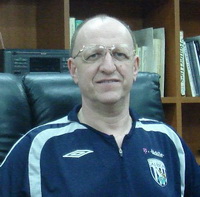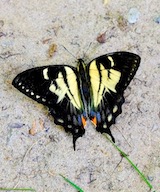-
alandmor

- Premium Member - 2024

- Posts: 52
- Joined: Tue May 24, 2022 4:38 pm
Re: Fumigant Lifetime
by alandmor » Sat Dec 02, 2023 7:36 pm
Image courtesy of Julieta Brambila, USDA APHIS PPQ, Bugwood.org
- Attachments
-
- Vaportape II.JPG (298.21 KiB) Viewed 5849 times
-
Cabintom

- Posts: 257
- Joined: Sat Jun 04, 2022 1:54 pm
Re: If you don't go out, you get nothing
by Cabintom » Sat Dec 02, 2023 12:03 pm
Back in the day, when you you could safely camp in the forest and travel around relatively freely, lots collectors would visit Mt. Hoyo, here in Ituri. A common staging point was Nyankunde, which had an airstrip, hospital and a significant ex-pat community given the size of the village. Nyankunde is not all that biogeographically interesting and so it seems very few bothered to do any collecting in the area.
I've collected the holotype of Neptis morosopsis and discovered a colony of Euchrysops kabrosae at the top of the hill directly behind the hospital.
-
wollastoni

- Site Admin

- Posts: 464
- Joined: Fri Mar 18, 2022 9:51 am
-
wollastoni

- Site Admin

- Posts: 464
- Joined: Fri Mar 18, 2022 9:51 am
Re: InsectNet Marketplace is down
by wollastoni » Fri Dec 01, 2023 7:32 pm
-
wollastoni

- Site Admin

- Posts: 464
- Joined: Fri Mar 18, 2022 9:51 am
Re: Yearly donation to the forum - Premium Members 2024
by wollastoni » Fri Dec 01, 2023 6:59 pm
Thank you !!!
-
adamcotton

- Global Moderators

- Posts: 768
- Joined: Tue Mar 22, 2022 12:24 pm
Re: How Genetic studies reveal new relationships, species
by adamcotton » Fri Dec 01, 2023 6:20 pm
Adam.
PS. I agree with John's comment just above. DNA characters are just that ... another category of characters. They should be taken into consideration alongside all other 'traditional' characters.
-
Chuck

- Premium Member - 2024

- Posts: 923
- Joined: Mon May 23, 2022 2:30 pm
Re: How Genetic studies reveal new relationships, species
by Chuck » Fri Dec 01, 2023 3:50 pm
While CO1 gives some insight- and clears up some of these issues, I'd hope there was SOME standard being set...or at least a baseline guideline.
I see a lot of stuff in BOLD BINs that are all roughly equal off the same branch, and presumably then all manner of taxa(?) could be named as species.
-
Chuck

- Premium Member - 2024

- Posts: 923
- Joined: Mon May 23, 2022 2:30 pm
Re: Yearly donation to the forum - Premium Members 2024
by Chuck » Fri Dec 01, 2023 3:17 pm
-
jhyatt

- Posts: 114
- Joined: Mon May 23, 2022 2:08 pm
Re: How Genetic studies reveal new relationships, species
by jhyatt » Fri Dec 01, 2023 3:14 pm
To me, DNA data is just another character to use in making what is fundamentally a subjective decision. The DNA % difference is neither stronger nor weaker evidence of speciation than morphology and biology. Species are biological facts, but the rest of classification, both higher and lower levels, is a human construct. At least, that's the way I look at the situation....Chuck wrote: ↑Thu Nov 30, 2023 7:50 pm Thanks Adam.
"Smaller difference in COI". Noting the other factors- range, flight period, etc. how the heck then would one determine Sp vs SSP considering COI?
If we use 2% as a safe range for species (noting that many are now less than that), what might be the difference for a ssp? Must be less than 1/3 of 1%, considering glaucus and appalachiensis.
I expect the answer is "it depends" and "the other factors" but then still....we can argue morphology all day, argue about distant populations, etc...even combining all the factors, are there ANY guidelines for Sp vs SSP now?
jh
-
wollastoni

- Site Admin

- Posts: 464
- Joined: Fri Mar 18, 2022 9:51 am
Re: InsectNet Marketplace is down
by wollastoni » Fri Dec 01, 2023 11:56 am
We should be back today or tomorrow.
-
wollastoni

- Site Admin

- Posts: 464
- Joined: Fri Mar 18, 2022 9:51 am
Re: Yearly donation to the forum - Premium Members 2024
by wollastoni » Fri Dec 01, 2023 9:59 am
Good to see you're always here to help !
-
Cassidinae

- Posts: 25
- Joined: Sun Oct 02, 2022 8:28 pm
Re: InsectNet Marketplace is down
by Cassidinae » Fri Dec 01, 2023 1:42 am
-
Chuck

- Premium Member - 2024

- Posts: 923
- Joined: Mon May 23, 2022 2:30 pm
Re: How Genetic studies reveal new relationships, species
by Chuck » Thu Nov 30, 2023 7:50 pm
"Smaller difference in COI". Noting the other factors- range, flight period, etc. how the heck then would one determine Sp vs SSP considering COI?
If we use 2% as a safe range for species (noting that many are now less than that), what might be the difference for a ssp? Must be less than 1/3 of 1%, considering glaucus and appalachiensis.
I expect the answer is "it depends" and "the other factors" but then still....we can argue morphology all day, argue about distant populations, etc...even combining all the factors, are there ANY guidelines for Sp vs SSP now?
-
adamcotton

- Global Moderators

- Posts: 768
- Joined: Tue Mar 22, 2022 12:24 pm
Re: How Genetic studies reveal new relationships, species
by adamcotton » Thu Nov 30, 2023 6:43 pm
Lots of new subspecies are described nowadays, probably they get less visibility.Chuck wrote: ↑Thu Nov 30, 2023 2:26 pm OK, next question! Subspecies.
I know IUCN doesn't recognize subspecies, but we all know it has been commonly used for centuries.
However, as of late, most of what I'm seeing is ssp or populations elevated to (or recognized as) full species. I can't even recall the last time I saw a new ssp described.
IUCN is a conservation body, and it puts emphasis on species conservation rather than individual subspecies. If you meant ICZN, it treats subspecies as one of two taxon 'ranks' in the Species-group, so I guess you probably do mean IUCN.
Subspecies generally have a smaller difference in COI between them than between species, but it is often best to treat subspecies as visibly distinguishable from the nominotypical population in the large majority of specimens.Chuck wrote: ↑Thu Nov 30, 2023 2:26 pm How do genetics play into this? The description of Dryocampa kendalli notes a difference in COI of 1.3% (plus morphological and range) from D rubicundra to call it a new species. Papilio appalachiensis COI differs .33% from glaucus.
Is subspecies simply out of vogue? We don't know what valid differentiators might define a subspecies?
Difference in COI sequences is only an indicator that two taxa may be separate species or subspecies. Mostly it is a good indicator, but sometimes distinct species have almost identical COI sequences (e.g. Papilio eurymedon and P. rutulus).
Adam.
-
Panacanthus

- Premium Member - 2024

- Posts: 115
- Joined: Tue May 31, 2022 7:51 pm
Re: Yearly donation to the forum - Premium Members 2024
by Panacanthus » Thu Nov 30, 2023 6:41 pm
-
Chuck

- Premium Member - 2024

- Posts: 923
- Joined: Mon May 23, 2022 2:30 pm
Re: How Genetic studies reveal new relationships, species
by Chuck » Thu Nov 30, 2023 2:26 pm
I know IUCN doesn't recognize subspecies, but we all know it has been commonly used for centuries.
However, as of late, most of what I'm seeing is ssp or populations elevated to (or recognized as) full species. I can't even recall the last time I saw a new ssp described.
How do genetics play into this? The description of Dryocampa kendalli notes a difference in COI of 1.3% (plus morphological and range) from D rubicundra to call it a new species. Papilio appalachiensis COI differs .33% from glaucus.
Is subspecies simply out of vogue? We don't know what valid differentiators might define a subspecies?
-
mothman55

- Premium Member - 2024

- Posts: 104
- Joined: Mon May 23, 2022 12:09 pm
Re: Yearly donation to the forum - Premium Members 2024
by mothman55 » Wed Nov 29, 2023 10:35 pm
-
Paul K

- Posts: 185
- Joined: Mon May 23, 2022 6:44 pm
Re: RIP Colin Smith (Nepal)
by Paul K » Wed Nov 29, 2023 2:29 pm
Wow 660 species in small, high altitude country.
In the whole Canada we have here just close to 300 species!
I just checked again and it’s not that small country, just because it is sandwiched between India and China looks so on the maps. Also includes almost all zones of south slop of Himalayan ridge which explain huge diversity of species.
It is for sure good place to visit but unfortunately I don’t think I will have the opportunity to do so.
-
Chuck

- Premium Member - 2024

- Posts: 923
- Joined: Mon May 23, 2022 2:30 pm
-
adamcotton

- Global Moderators

- Posts: 768
- Joined: Tue Mar 22, 2022 12:24 pm
Re: RIP Colin Smith (Nepal)
by adamcotton » Wed Nov 29, 2023 9:58 am
Colin Smith, maths teacher who became an authority on the butterflies of Nepal – obituary
He spent the last six decades of his life in the Asian republic, where he was known as ‘Putali Baje’, or ‘Butterfly Grandpa’
By
Telegraph Obituaries
9 November 2023 • 6:00am
Colin Smith, who has died aged 87, travelled to Nepal aged 29 to teach mathematics, science and English and stayed on to become an authority on the country’s butterflies.
Nepal is one of the best places in the world to see butterflies. Of the 17,500 or so known species, 660 are found in Nepal, of which 20 are on the endangered list. Smith dedicated more than 50 years to their study, publishing numerous research papers and several books and becoming known by locals as “Putali Baje” (“Butterfly Grandpa”).
Colin Philip Smith was born on November 24 1936 in Highgate, north London, to Ebenezer Smith and Rose, née Boosey. As a boy he often visited an uncle whose collection of butterflies and moths sparked an interest which he pursued during school holidays at Boy Scout summer camps.
After taking a BSc in mathematics at Imperial College London, followed by an MSc at University College, he became a teacher, and in 1966 volunteered to serve with the United Mission to Nepal (UMN), a venture involving a number of Christian groups. “I was told that alongside teaching, I needed to have a hobby, too,” he recalled. “I told them that I collected butterflies.” The UMN suggested that he make a collection from Nepal to bring back home.
Instead he decided to stay, and while teaching at a school in Pokhara he met Dorothy Merow, a fellow teacher who had started a small natural history museum and who persuaded him to collect butterflies for it.
After seven years’ teaching Smith decided to devote himself full-time to butterflies. His rare visits to England thereafter included a trip in 1976 to the Saruman Museum (aka the National Butterfly Museum) to learn the latest techniques for handling specimens.
Back in Nepal, he started writing for local natural history journals and in 1989 published his first major study, Butterflies of Nepal (Central Himalaya). His initial goal was to collect specimens of all the 660 species of butterflies found in Nepal with a view to publishing a comprehensive checklist; later, however, he turned to capturing butterflies with a digital camera. His Illustrated Checklist of Nepal’s Butterflies was published in 1995.
In the early 2000s Smith began working mostly on Nepal’s far more numerous moth species, travelling round the country with a fluorescent bulb and a white sheet, collecting specimens for Kathmandu University. Other publications include Lepidoptera of Nepal (2010) and A Photographic Pocket Guide to Butterflies of Nepal, In Natural Habitat (2011).
For many years Smith lived with the family of a Nepali fellow lepidopterist near Pokhara, but in 1995 he bought a small plot of land nearby and built himself a tiny one-room cottage. Last year he was reported to be living on a British pension of £175 a month along with an elderly allowance of 4,000 Nepalese rupees (around £24.50). “I was maybe the richest man in Pokhara in my prime,” he reflected, “But now I’m probably the poorest.”
In 1995 he made the first of several attempts to be granted Nepalese citizenship, but it was only in 2019, after friends organised a petition, and after Smith had been ill for several years, that the government finally responded, and he became the third foreigner, after Sir Edmund Hillary and Toni Hagen (the first foreigner to travel throughout Nepal), to be granted honorary citizenship.
Nepal is now struggling with the social and environmental costs of mass tourism, but in an interview last year Smith recalled that when he first arrived, there were “hardly any roads, let alone vehicles. Only one foreigner had a bicycle.”
Other than a brother living in New Zealand, Smith had no other close relatives. His wish was to have his ashes scattered on the Seti River that flows down from the Annapurna mountains.
Colin Smith, born November 24 1936, died November 4 2023
